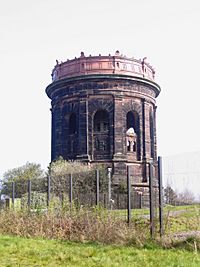Norton Water Tower facts for kids
Quick facts for kids Norton Water Tower |
|
|---|---|

Norton Water Tower
|
|
| Location | Norton, Runcorn, Cheshire, England |
| OS grid reference | SJ 553 816 |
| Built | 1892 |
|
Listed Building – Grade II
|
|
| Designated | 31 October 1983 |
| Reference no. | 1335884 |
| Lua error in Module:Location_map at line 420: attempt to index field 'wikibase' (a nil value). | |
The Norton Water Tower is a tall building in Norton, Runcorn, Cheshire, England. It's a special kind of tower that helps store and move water. This historic tower is officially recognized as a Grade II listed building, meaning it's important and protected.
History of the Water Tower
The Norton Water Tower was built a long time ago, between 1888 and 1892. Its main job was to help move water from Lake Vyrnwy in North Wales all the way to Liverpool. It acted like a "balancing reservoir," which means it helped keep the water pressure steady.
Water travels to Liverpool through a huge tunnel. This tunnel is about 10 feet (3 m) wide and goes under the River Mersey. The tower was designed by George F. Deacon. He was the main engineer for the Liverpool Corporation Waterworks Department.
What the Tower Looks Like
The tower is made from red sandstone and shaped like a giant cylinder. It stands about 99 feet (30 m) tall and is 82 feet (25 m) wide. On top of the tower, there is a large cast iron tank. This tank can hold a massive 650,000 gallons of water!
Around the outside of the tower, there are ten tall, flat columns called pilasters. Between these columns, you can see round-shaped arches. Above these arches, there's a decorative band called a frieze. This frieze has a special message written in Latin.
The Latin Message
The Latin message on the tower's frieze tells an interesting story. When translated into English, it says: "This water, derived from the sources of the Severn, is brought to the City of Liverpool, a distance of eighty miles, through the mountains and over the plains of Wales and the intervening country, at the cost of the municipality, in the year of Our Lord 1892."
This message explains that the water comes from the River Severn's sources. It travels 80 miles (about 129 kilometers) to Liverpool. The city paid for this huge project, and it was finished in 1892.

